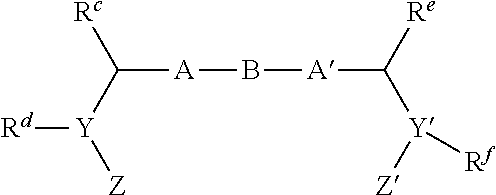Inhibitors of hcv ns5a
- Summary
- Abstract
- Description
- Claims
- Application Information
AI Technical Summary
Benefits of technology
Problems solved by technology
Method used
Image
Examples
example 1
Preparation of Biphenyl Core Structures
[0395]Scheme 1-1 depicts the general synthesis of a number of representative core structures that contain a biaryl unit. For illustrative purposes, a substituted phenyl ring is used to represent an aryl group. The phenylimidazole intermediate A-1, prepared by modifying reported procedures and detailed later, is converted to its corresponding borate by treatment with a diborane agent such as 4,4,4′,4′,5,5,5′,5′-octamethyl-2,2′-bi(1,3,2-dioxaborolane) in the presence of a palladium catalyst, typically Pd(dppf)Cl2, and a base such as triethylamine to give the arylborate intermediate A-1a (borates, A-2a, A-4a and others can be prepared similarly and used in similar fashion as A-1a in the following step). Under the similar cross coupling conditions (Suzuki reaction), compound A-1a (or A-2a or A-4-a) reacts with an aryl bromide or iodide such as A-3, A-4 or A-5 to give the respective cross-coupled product B-1, B-2, B-3 or B-4. Using the preparation o...
example 2
Preparation of Aryl Ether Core Structures
[0429]
[0430]Scheme 2-1 illustrates one of the ways to prepare molecules containing an arylether, thioarylether moiety as the central scaffold. The Ra's are each independently present or absent. The synthesis starts with a Friedel-Craft acylation reaction between a biaryleather or thiobiaryl ether compound 7-1 with chloroacetyl chloride (or bromoacetyl bromide to obtain the corresponding dibromide). Alkylation of the resulting bischloroacetylphenone, 7-2, with N-protected L-proline to give the bisprolinyl ester 7-3. When such a bis ester is treated with an excess amount (10 equivalents) of ammonium acetate in toluene or xylenes under heating, the bisimidazole compound 7-4 is formed. Those skilled in the art will know that other means to assemble such a structure do exist, including the formation of an amide equivalent of intermediate 7-3 prior to the imidazole ring formation, or the introduction of the imidazole moiety via a cross coupling ope...
example 3
Preparation Biphenyl Analogs
[0435]Once the core scaffolds are built, they can be further converted to analogs intended for enhancing antiviral potency and physicochemical properties, primarily through the further functionalization of the terminal amino groups (pyrrolidines as in these examples shown).
[0436]Scheme 3-1 illustrates two major routes (A and B) for further functionalizing the central scaffold. R2 and R3 in Scheme 3-1 are defined as Ra in formula I. R1 and R4 in Scheme 3-1 are defined as R in formula I. R in Scheme 3-1 is defined as R5 in formula I. In route A, where the nitrogen protecting groups, P and P′, are introduced to be the same or both are unmasked at the first step (B-1 to B-1-1), both ends of the molecule can undergo further transformations in parallel fashion. In Route B, the orthogonally protected nitrogen atoms of the pyrrolidines are unmasked selectively and the two ends of the molecules are functionalized individually, allowing for the introduction of diff...
PUM
| Property | Measurement | Unit |
|---|---|---|
| Composition | aaaaa | aaaaa |
Abstract
Description
Claims
Application Information
 Login to View More
Login to View More - R&D
- Intellectual Property
- Life Sciences
- Materials
- Tech Scout
- Unparalleled Data Quality
- Higher Quality Content
- 60% Fewer Hallucinations
Browse by: Latest US Patents, China's latest patents, Technical Efficacy Thesaurus, Application Domain, Technology Topic, Popular Technical Reports.
© 2025 PatSnap. All rights reserved.Legal|Privacy policy|Modern Slavery Act Transparency Statement|Sitemap|About US| Contact US: help@patsnap.com



